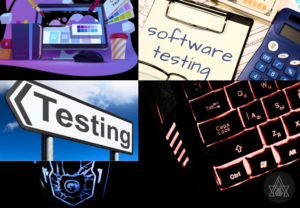Software Testing Techniques – 1
Introduction
Software testing is a vital component of the software development life cycle since it guarantees that the final product fulfills quality requirements and functions as expected. The primary objective of software testing is to uncover errors, malfunctions, or discrepancies between expected and actual software system behavior. To accomplish this purpose, software developers and quality assurance teams use a number of testing approaches to validate functionality, analyze overall performance, and identify software defects.
This report provides an in-depth assessment of various fundamental software testing techniques. Throughout this report, we will go through each testing technique in depth, emphasizing its significance and benefits. We will discuss how black box testing focuses on the software’s external behavior, white box testing on its internal structure, and how grey box testing combines components of both approaches. We will also look at techniques such as boundary value analysis, equivalence partitioning, and decision table testing, which all aid in identifying defects and providing complete test coverage.
In addition, we will look at state transition testing, which examines the behavior of software during state changes, and exploratory testing, which emphasizes flexibility and creativity in discovering defects. Furthermore, usability testing, performance testing, and security testing will be discussed because they are critical for producing software solutions that fulfill user expectations while also being robust, efficient, and secure.
Understanding and using these testing procedures can help software developers and quality assurance professionals enhance customer satisfaction while also contributing to the marketability and success of software products.
Black box testing
Definition – Black-box testing is a one of the software testing techniques that focuses on requirements and functions. Understanding the inner workings or implementation of the software under test is not required. Without having access to the source code, testers use specified inputs and predefined outputs to analyze the output.
Goals – Black box testing verifies the requirements and functionality of software. By focusing on overall performance and user experience, it identifies problems and errors without having any understanding of the internal operations.

Techniques
- Equivalence Class Partitioning : Input values are categorized into groups based on expected outcomes. Testers focus on representative values from each group to achieve comprehensive coverage efficiently.
- Boundary Value Analysis : Testing edge or boundary values of input ranges to uncover issues commonly found near these boundaries. It involves testing both valid and invalid inputs to detect problems associated with the boundaries.
- Decision Table Testing: Capturing system conditions and relationships in a table format. Testers create combinations of inputs and corresponding actions to test unique scenarios and ensure comprehensive coverage.
- State Transition Testing: Analyzing system states and transitions during specific circumstances. Test cases are designed based on specified state changes. Visual diagrams help understand event-driven behavior.
- Error Guessing Testing: Leveraging tester’s experience to uncover defects by guessing potential errors based on past knowledge. It targets error-prone areas to improve test coverage and overall testing effectiveness.
Advantages and Limitations of Black box testing
| Advantages | Limitations |
| Test cases can be designed early based on complete functional specifications. | May not identify defects related to internal workings. |
| Not dependent on programming language or technology, making it applicable to various applications. | Challenging test case design without clear functional specifications. |
| Identifies defects from a user’s perspective, enhancing the overall user experience. | Difficulty in identifying tricky inputs without specific test cases |
| Balanced and unbiased testing | Limited testing time may hinder comprehensive input coverage and slow down test case development |
| Enhances the overall user experience | Possibility of unidentified paths during testing, leading to potential issues being missed |
Testing process
- Input: Analyze system requirements, specifications, and code to select valid and invalid inputs.
- Processing: Create test cases and run them, paying attention to how external systems behave. Conduct extra load, stress, security, and globalization testing.
- Output: Obtain desired results and prepare a comprehensive report, documenting testing process, defects, and resolutions.

Testing Tools
Black box testing greatly benefits from automated tools, which increase effectiveness and accuracy. Some commonly used behavioral testing tools
Eg: Appium, HP QTP, Selenium, Applitools, Microsoft Coded UI.
Black box testing vs. White box testing
| Aspect | White-box Testing | Black-box Testing |
| Analysis of Internal Working | Focuses on fundamental aspects of the internal working | Ignores internal behavior and focuses on external exceptions |
| Testing Performed By | Developers and testers | End users, testers, and developers |
| Test Design | based on high-level data flow diagrams and database diagrams, etc. | Based on high-level specifications and requirements |
| Exhaustiveness and Time | Potentially most exhaustive and time-consuming | Somewhere in between in terms of exhaustiveness and time consumption |
Best practices
- Early involvement of testers: Testers participate in planning and requirements gathering, improving test coverage and issue identification.
- Risk-based testing: Prioritizing testing based on identified risks lowers product risk before deployment, focusing on critical areas.
- Leveraging automation tools: Automation tools automate repetitive and manual testing operations, increasing efficiency and enabling early issue detection.
- Continuous monitoring and improvement: Ongoing assessment and improvement of testing operations to enhance the testing process.
White box testing
Definition – White box testing is a testing method where the internal organization, style, and code of the software are inspected to confirm the input-output flow and enhance design, usability, and security. It entails testing while aware of the inner workings of the software
Testing Types –
- Unit Testing: Software is tested on specific components or units to make sure it works as intended. It focuses on validating the functionality of each unit.
- Integration Testing: Testing the combination of individual software modules to uncover faults and errors in the integrated components. It can be performed using a top-down or bottom-up approach.
- Regression Testing: Ensuring that previously developed and tested software still functions correctly after changes or interfaces with other software. It verifies that new code changes do not impact existing functionality.
- System Testing: Testing the system as a whole unit, evaluating both functional and non-functional attributes. It assesses reliability, maintainability, security, and compliance with requirement specifications.
Techniques
Code Coverage
- Measures test suite effectiveness in terms of software system coverage
- Challenges in deploying at scale due to perceived usefulness and computational costs
Control Flow Testing
- Structural testing approach using program’s control flow as a model.
- Prioritizes simpler paths for comprehensive testing.
Data Flow Testing
- Structural testing strategy analyzing program variable definition and usage.
- Annotated control flow graph for effective testing.

Advantages and challenges in White box testing
| Advantages | Challenges |
| Comprehensive code coverage | Time and resource-intensive |
| Efficient identification and fixing of issues | Test cases may become irrelevant due to code changes |
| Code optimization and error detection | May miss partially implemented or missing features |
| Encourages evaluation and improvement of code | Difficult to implementation and design |
Tools
Code analyzers are tools that examine source code to find potential problems such coding errors, vulnerabilities, and a lack of compliance to coding standards. Eg: SonarQube, FindBugs
Debugger: Debuggers are tools that help developers and testers identify and fix bugs or errors in software programs. Eg: GNU Debugge, Visual Studio Debugger
Code Coverage Tools: Code coverage tools measure the extent to which a test suite exercises the codebase. Eg: JaCoCo, Cobertura
Best practices for White box testing
- Start testing early in the development process.
- Use a combination of different techniques and tools to achieve the best results.
- Continuously evaluate and improve the testing process to ensure its effectiveness
- Use debugging tools to identify and address issues in the code.
- Analyze test results to identify bugs and their causes for improvement.







I also think hence, perfectly indited post! .
Pingback: Software Testing Techniques - 2 - Article Prism
Hello, Jack speaking. I’ve bookmarked your site and make it a habit to check in daily. The information is top-notch, and I appreciate your efforts.